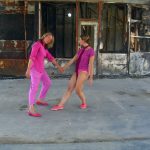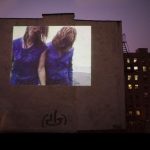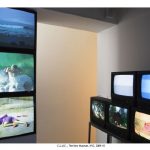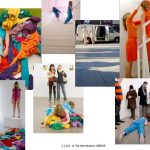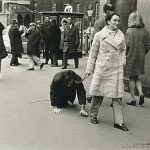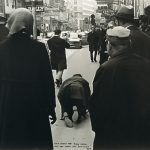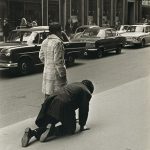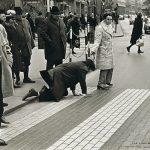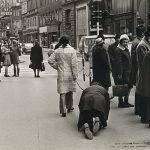“C.L.U.E. (color location ultimate experience) is a collaborative video, installation and performance work by artists A.L. Steiner + robbinschilds, with AJ Blandford and Seattle-based band Kinski. The performance and installation-based works have been presented in exhibition and performance venues internationally. The video works range from a single-channel piece (C.L.U.E., Part I), to multichannel pieces, up to 13-channels. ” (credit)
Category Archives: Crawling
VALIE EXPORT/Peter Weibel, Aus der Mappe der Hundigkeit (From the Portfolio of Doggedness) (1968)
“VALIE EXPORT/Peter Weibel, Aus der Mappe der Hundigkeit (From the Portfolio of Doggedness), (1968)
Documentation of the action 5 black-and-white photographs, vintage prints, 40.3 x 50.3 cm / 50 x 40.3 cm each, framed between 2 glass plates, flush 40.3 x 50.3 cm / 50 x 40.3 cm each, fixed with black textile adhesive tape Photographer: Josef Tandl
Five black and white photographs document the action From the Portfolio of Doggedness, which VALIE EXPORT and Peter Weibel carried out in Vienna in February 1968. EXPORT took her fellow artist for a walk—he crawled behind her on all fours on a leash—along the Kärntner Strasse in Vienna, one of the central streets and main shopping areas. This “sociological and behavioral case study” (EXPORT) belongs to the actionistic tradition. “Here the convention of humanizing animals in cartoons is turned around and transferred into reality: Man is animalized—the critique of society as a state of nature” (Weibel). Turning around a piece of normal social behavior makes transparent a particular symbolic order—that of gender specifics—and subjects it to criticism. Here, an active woman leads a passive man on a leash. Crawling, a form of animal behavior, is not, however, a reference to liberation from moral and political discipline or a “better” system. Rather, it points out the necessity of restructuring the social order that has been handed down to us. Photography has a documentary function here, it acts as an “ethno-graphical” study and shows particular communication processes in the observable reactions of the onlookers. The structures of the gazes disclose social behavior and contrast with the action. (Claudia Slanar)” (credit)
Carolee Schneeman, Labyrinth (1960)
“I had composed my first live outdoor event, Labyrinth, 1960, after a tornado blew through our fragile cottage in Illinois, bringing down trees and raising mud, dirt, and rocks from the streambed. Friends were invited to follow instructions written on cards to crawl, climb, and interact with the landscape. The passage was initiated by my cat walking through a smashed kitchen window, in acceptance of this altered space. As a landscape painter, I recognized this gesture as breaking the traditional frame, which would soon lead me to develop movement principles within the Judson Dance Theater.” [credit]
Shigeko Kubota, Vagina Painting (1965)
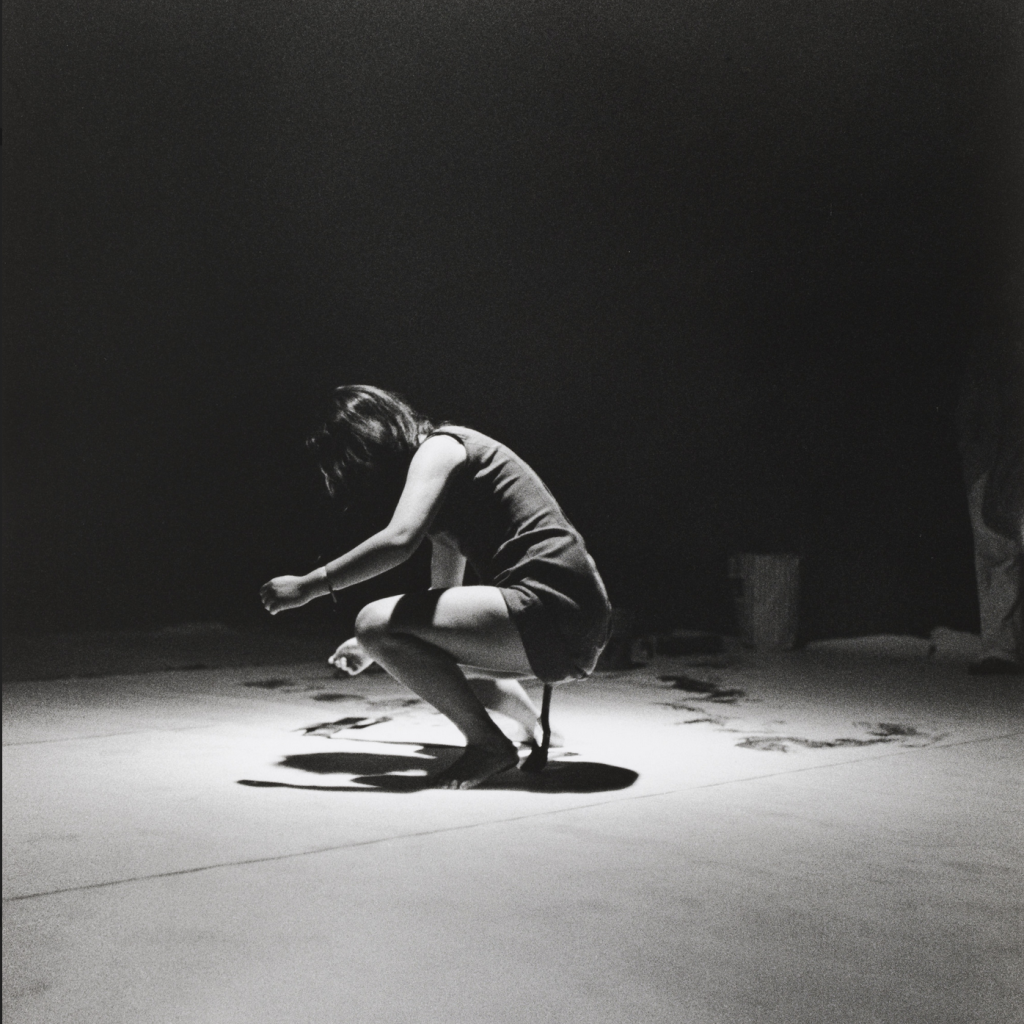
Shigeko Kubota Vagina Painting, performed during Perpetual Fluxfest, Cinematheque, New York, July 4, 1965
Shigeko Kubota (1937-2015)
“Born in 1937 in Niigata, Japan, Shigeko Kubota became a key member of the Japanese avant-garde, a respected participant in New York Fluxus events in the 1960s, and, starting in the 1970s, a pioneering practitioner of video art. Upon graduating from the Tokyo University of Education in 1960, she fell in with members of the avant-garde movements Group Ongaku, Hi Red Center, and Zero Jigen. These groups pushed art’s boundaries, incorporating music, performance, and movement into their work, with which they questioned the centralized authority of the postwar Japanese government and what they viewed as its focus on economic growth at the expense of the well being of individual citizens. Their experiments were also in keeping with the activities of Fluxus artists like George Maciunas and John Cage, whose works were highly regarded by the Tokyo avant-garde. Fluxus was an international, interdisciplinary movement that promoted experimentation across mediums, and a number of Japanese artists became important members, including Ay-O, Takako Saito, Yoko Ono, and Mieko Shiomi (who moved to New York with Kubota in 1964).
Because critics in Japan ignored most avant-garde art, and were particularly dismissive of women artists, Kubota decided that she would have better career opportunities in New York, where she was immediately accepted into the Fluxus community. Maciunas dubbed her the “vice president of Fluxus” for helping him to organize events and distribute mail art, and for her active participation in activities including the “Fluxus dinner commune”—a short-lived series of communal dinners prepared and attended by Fluxus artists, who would conclude the meals by making objects—and the production of multiples, small, multi-editioned works that were frequently produced collaboratively. Kubota also produced some of her own Fluxus objects, including Flux Napkins (c. 1967) and Flux Medicine (c. 1966).
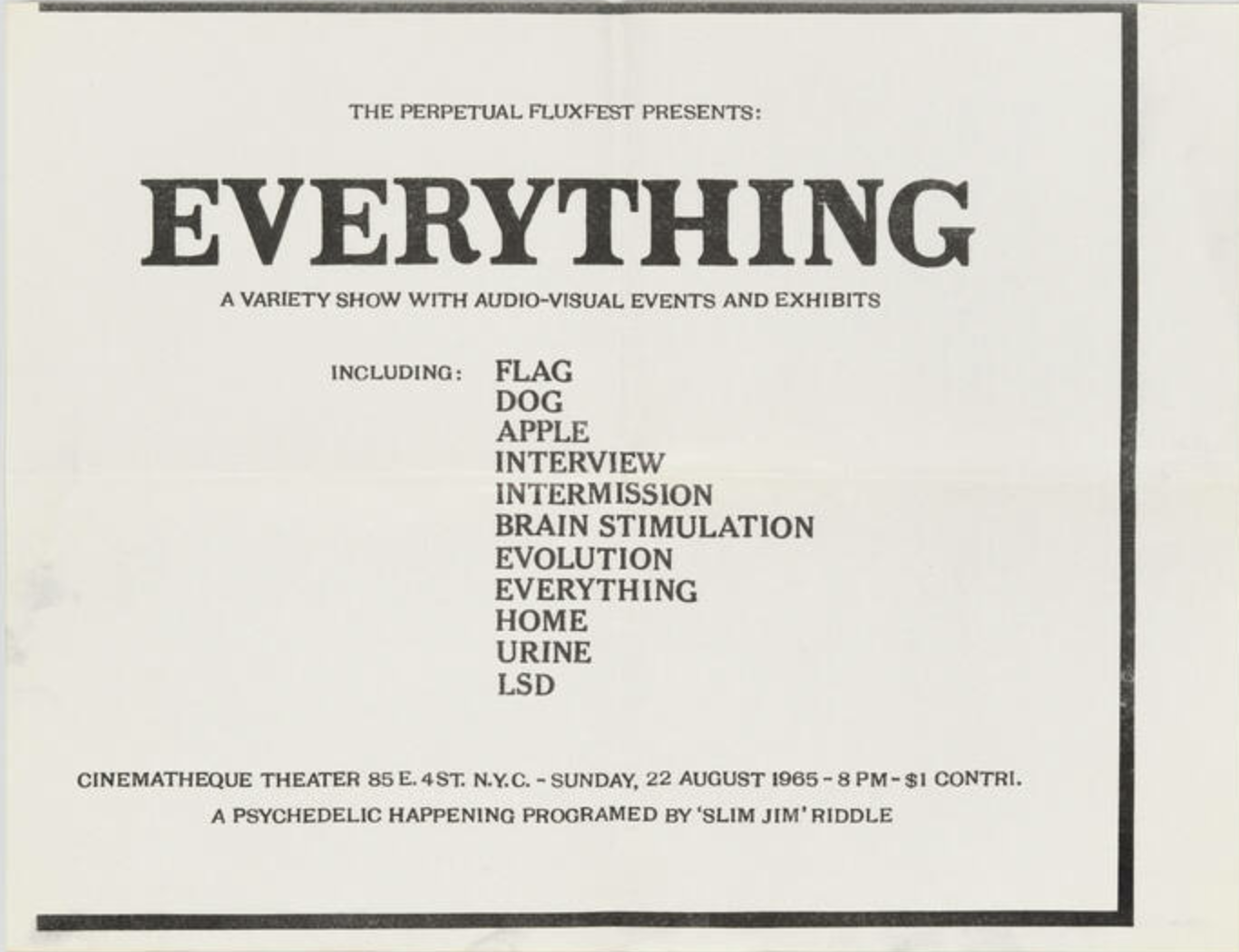
James Riddle, Fluxus, “THE PERPETUAL FLUXFEST PRESENTS: EVERYTHING” (1965) [credit]
Following Vagina Painting, Kubota turned away from performance and began exploring new media, particularly video, which would comprise the bulk of her output for the rest of her career. Duchampiana: Nude Descending a Staircase (1976)—which features three video monitors embedded in a plywood staircase showing a nude woman walking down stairs—reveals her indebtedness to Marcel Duchamp. This was the first video sculpture acquired by MoMA. Kubota and her husband, Nam June Paik, pioneered the development of video art, exploring the aesthetic, technological, emotive, and even organic potential of this new medium.” [credit]
La Monte Young, Composition 1960 #10
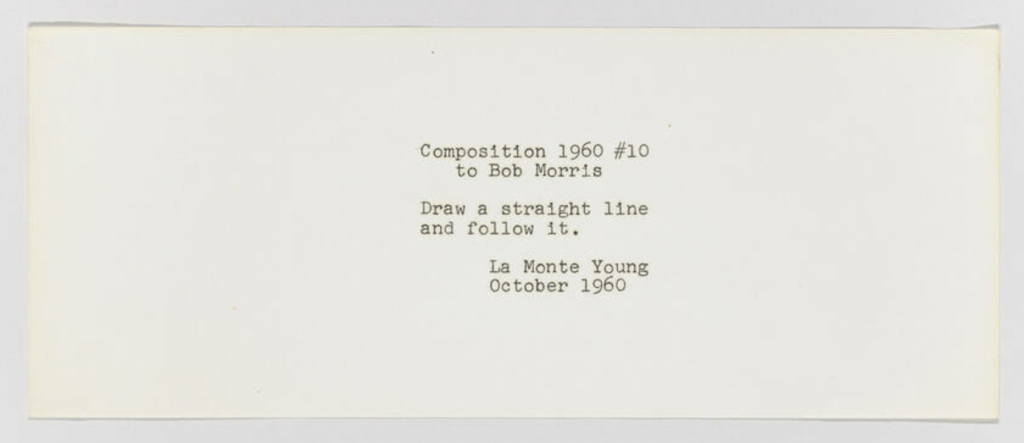
La Monte Young “Composition 1960 #10” (1960) typewriter ink on paper, 3 3/8 × 8 9/16in.
La Monte Young‘s Composition 1960 #10, simply states, “Draw a straight line and follow it.” Young (1935-) was a well-known member of Fluxus.
Credit: Waxman, Lori. Keep Walking Intently: The Ambulatory Art of the Surrealists, the Situationist International, and Fluxus. Sternberg Press, 2017. Page 206.
—
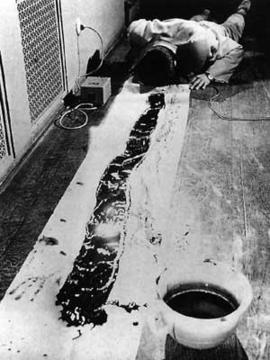
Nam June Paik “Zen for Head” (1962) [credit]
—
Trisha Brown, It’s a Draw/Live Feed (2003, 2008)

Trisha Brown “It’s a Draw/Live Feed” 2008

Trisha Brown “It’s a Draw/ Live Feed” 2003
“In these large-scale drawings, realized through performance on a stage, in a gallery, or in the privacy of the studio, signs written on the body through dance training, memory and improvisation, take the form of pictorial signs motivated by gestures traced on the page. In the It’s a Draw series, the ground of drawing, paper, which is horizontal to the floor, becomes vertical when installed on a wall, a situation that recalls conditions Brown considered fundamental when shifting her work to the proscenium stage with its perpendicular and horizontal frames of floor and stage.5 The motivation of matter by physicality echoes in relation to artistic traditions encompassing Jackson Pollock’s “action painting,” Yves Klein’s anthropometries, 1950s–1960s performance, as well as sculpture and video concerned with the body’s phenomenological experience and with process.
Of course, Brown’s singular drawing language depends on unprecedented kinesthetic articulation and memory, as well as a visual ordering that takes into account improvisation and composition that is simultaneously physical and visual.”
“The It’s a Draw drawings deflect form by investigating process, although over time her repertoire of indexical marks have become a versatile, dependable and autonomous visual language, an evolution that reveals the gradual differentiation, repetition, combination and invention of mark-making systems. This is reflected in two recent drawings related to the series, although smaller in scale. The first, made primarily with the feet grasping charcoal and pastel is a constellation of twirls, smudges, dashes and dots made by the “jump” of charcoal across the page. An archive of signs for unrecoverable actions, arrayed like a series of words on a white page with the empty white spaces suggesting the beat of time between drawing incidents or events.
Process, the idea of drawing as a record of the physical act of its making, is moderated by Brown’s inimitable visual intelligence and penchant for structure. Comparing a group of drawings from the It’s a Draw group will underscore how decision-making moderates the random. One recent drawing incorporates a record of procedures and edits as a further layer of (choreographic and graphic) notation such as directional arrows, writing and color. Of course, only the choreographer can read the visual signs of dance that are a presence behind each drawing’s realization, now evaporated, absent.
Technically the It’s a Draw drawings are not “blind” drawing: the eyes are open, although constantly in motion in all directions.”
Credit: “Trisha Brown: The Signs of Gesture” by Susan Rosenberg in brochure for USF Contemporary Art Museum (Brown-Brochure)
Pope.L , The Great White Way: 22 miles, 9 years, 1 street, Broadway, New York (2001-09)

William Pope L., “Training Crawl”, (for The Great White Way: 22 miles, 5 years, 1 street), 2001. Lewiston, Maine. Performance photographs. © William Pope L. Courtesy of the artist.
Check out this descriptive article from 2003, from the work in-progress:
“The socio-economic implications of Broadway are enormous, and examining what Broadway “represents” is the first key to making some sense of William Pope.L’s complex, ongoing street performance The Great White Way.”
“Since the late 1970s, Pope.L has been infecting the streets of New York with periodic street performances, reminders that the country, city, and culture he lives in have a long way to go before the discomforts of race and stereotyping have safely receded.”
In this work, Pope.L crawled the full length of Broadway.
The entire crawl was recorded on video and later edited.
Gail Burton “Crawl” (2010)
Crawl

On Saturday 29th May 2010 I performed ‘Crawl’ as part of ‘Look Harder,’ an exhibition of site specific and performance art at Alexandra Palace Park. ‘Look Harder’ was organised and curated by Tony Peakall and Judith Brocklehurst of Rekindle Arts, and included art work by Judith Brocklehurst, Tim Flitcroft, Calum F. Kerr, Miyuki Kasahara, Marco, Tony Peakall and Sarah Sparkes, amongst others. Art works and performance were situated in the vicinity of the lake in Alexandra Palace Park. (Click on Look Harder exhibition for more details of the exhibition). This was the second year that the exhibition had taken place; I also participated in the first exhibition, when I created a banner and performed three solo marches carrying it. (Click on over, banner, march, Alexandra Palace, protestation or tags in the sidebar for posts about the banner march and the first exhibition.)
Crawl was proposed as a counterpoint to a march; its antithesis. It was intended to embody a private world of defeat. I envisaged a temporary escape to a different world; different to our usual sensory experiences, to our ordinary measures of temporality, to notions of patience and endurance:
‘I will crawl on my hands and knees, my face and fingers in the dust and dirt. Crawling, I will exit the biped world, relinquishing verticality and the customary plane of society. I will move slowly, perhaps painfully, aware of my body’s awkwardness. Conscious of the detail, detritus and texture of my passage, the aromas and acoustics of movement close to the ground, I will crawl a complete circuit of the lake of Alexandra Palace Park. The antithesis of a march, the crawl will embody the private, the broken, the beaten, the small and the slow.’
The invitation to watch my crawl was also extended to visitors to the park who might wish to perform their own crawl; letters suggesting and inviting a crawl, addressed to ‘Dear Visitor,’ were left in the Lakeside Café. (View or download a Crawl letter here).
